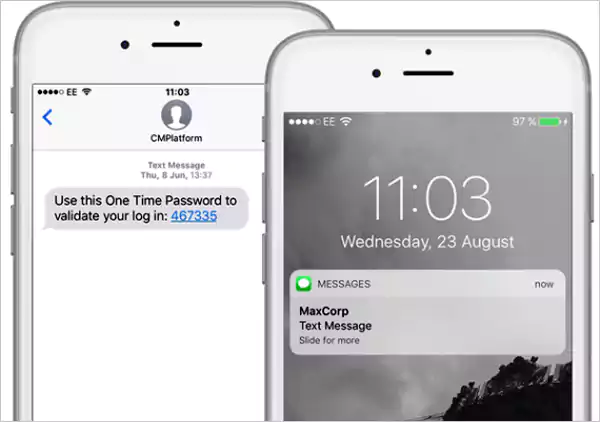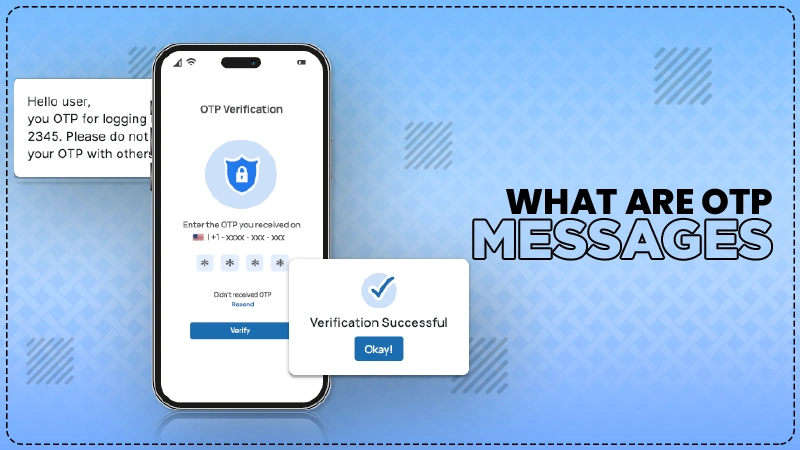
In the digital age, the world is heading to, security seems more important than ever. The internet is a hub for countless accounts and sensitive details.
That’s said, are you tired of constantly receiving generic and impersonal messages? Or Do you want to come across a secure and convenient way to verify your identity in general?
If that’s the case, look no further than OTP messages. Since cyber threats are rampant, OTP texts will pull you out of the danger. Today, those little codes you receive via text when you are verifying an app or logging into your bank account have become an essential tool for ensuring safety.
But, do you know what exactly OTP messages are and how they work? We are here to answer your questions surrounding OTP texts.
Keep on reading to find out the significance of OTP messages, how it works, applications, examples, benefits, and more.
Understanding OTP Messages
OTP messages, or One-Time Passwords are temporary codes sent to users for authentication purposes. It acts as a shield or a layer of security during logins or transactions.
For example, this ensures that the person logging in is indeed the correct account holder, similar to how Instagram protects your private interactions or how YouTube secures your media-sharing experience, making it reliable as a social media platform is YouTube social media?.
As most of you know, OTP codes can come via SMS or through dedicated apps. However, the users receive a 6 to 8-digit code that must be entered within minutes. This immediately even makes it a great choice for securing sensitive transactions.
How Do OTP Messages Work?
Understanding how text message OTP works won’t require anyone to be a computer science engineer. This is because it functions space on a straightforward principle of authentication.
Let’s illustrate with an example:
You are attempting to log in or complete a transaction. To move ahead, you came across an option to request an OTP. The request can be made either by customers or the institution they are dealing with.
At this point, the OTP text is generated automatically and sent directly to the registered mobile number or email. The randomly generated OTP is made up of a semi-random number or string of characters.
Upon receiving the OTP text message, you are supposed to enter the code in the application or website. If you have entered the correct one within the specified timeframe, you will successfully gain access to your account or complete the transaction.
OTP codes are short-lived, preventing future access if intercepted, similar to how other apps protect sensitive actions, such as resetting the Instagram Explore Page to safeguard your interests.
The Importance of OTP Messages in Today’s World
Now that you know what are OTP messages, let’s have a glimpse at their importance in today’s world. The need for secure authentication methods grows as a cyber threat gets more sophisticated.
First thing first, this adds a layer of barrier and ensures even if somebody gains access to your username and password, they will not log in unless they have that unique code sent directly to you.
Beyond just security, they even enhance user experience by providing quick access. Businesses today are even relying on it to build trust with their customers.
Types of OTP Texts
There are majorly three types of OTP texts. Those are mentioned below:
Voice Message
A voice message OTP is delivered to the user through an automated phone call.
When someone opts for the voice OPT, then they receive a call from a designated phone number and hear an automated message containing their unique OTP code.
This is especially beneficial for individuals with limited sight.
Push Notification
Push notifications are another secure method, sending OTPs directly without manual entry. This mirrors the convenience found in social media, such as reposting Instagram stories with ease.
One noteworthy advantage of push notifications is that they eliminate the need for users to manually enter codes. This benefits by making it more convenient and dependable for users.
SMS Message
As the name suggests, SMS OTPs are sent to the user’s mobile phone via text message. These are widely accepted by most mobile devices.
So, if an individual initiates an action that requires authentication, such as completing a banking transaction or resetting a password, they will end up receiving an SMS with their unique OTP code.
Examples of OTP Messages
Depending on the service you are using, OTP messages come in various forms. Below, we have mentioned a few examples of the same:
- E-commerce: Websites or Apps often use OTPs for transaction confirmations. Users typically receive a message saying “Your verification code is 123456. Please enter this code to continue”.
- Social Media Platforms: Want to know what OTP text message meaning in social media? Platforms like Facebook, Instagram, and LinkedIn also utilize OTP texts. You might see something like “To verify your identity, please enter the following one-time password: 789012”.
These examples illustrate how diverse and vital OTP messages are across different sectors.
What Makes OTP Messages a Safer Option?
Many would find OTP messages simple text, but actually, it is a gateway to a safer digital world. It safeguards individuals and businesses alike over traditional forms of verification.
Now, to answer the question, what makes it a safer option? Here are some points to look ahead:
- Unique and Time-Sensitive Codes: Messages OTP are unique and time-sensitive codes that are only valid for a short period. This prevents hackers from using the same code again.
- Two-Factor Authentication: OTP texts are often part of a factor authentication or multi-factor authentication process. So, even if someone has obtained the user’s password, they still cannot access the account without an OTP code.
- Direct Delivery to User’s Device: Unlike traditional methods, these are directly delivered to the user’s registered device. This will make sure that only the intended recipient has access to the code.
- No Personal Information Required: To get one, there is no need to provide any personal or sensitive information, which might include your name or address. Hence, eliminates the risk of personal details being compromised in case of a data breach.
- One-Time Use: Message OTP becomes invalid after the use. So even if the hacker manages to obtain the code, they cannot use it again to access the account.
- Compliance with Data Protection Regulations: Many industries have strict data protection regulations that require a secure method of authentication to access the details.
Want to know what role an OTP has to play? It helps organizations comply with these regulations and protect user data.
Exemplary Uses of OTP Messages
Apart from its uses in industries, the use cases of OTP texts are:
Noting Out-of-Pattern Transactions
This is the most common use case of OTP messages. It usually refers to a transaction that is not typical or consistent with their usual habits.
For example, if you make small purchases every day or occasionally from a local store. But, suddenly you end up making a large purchase from an International website. Now, this would be considered an “out of pattern” transaction.
In such a situation, banks may send an OTP to the user’s registered phone number or email address as an extra layer of security. And the users are supposed to enter the OTP to confirm the transaction and prove their identity.
Accessing Government Services
Today government services are even relying on online platforms for convenience and efficiency.
To name some services, might include tax records, social security numbers, and healthcare data.
Applying for Bank Payment Cards
Mostly, when someone receives a new bank payment card (like a credit or debit card) they need to activate it before they can start using it for transactions.
For that, OTP text is required to activate the cards.
Resetting Lost Passwords
The problem of forgetting passwords has become common for users of online services and platforms. Most websites and apps use OTP messages for verification to reset a password and access.
Once the OTP is entered then only a user can confirm their identity and reset their password.
Beginning to Sign in for Services
Signing in to a service or platform? The identity of new users can be verified by using OTP messages to ensure that they are legitimate.
Final Words
OTP messages, or One-Time Passwords are just a common method used to protect sensitive information. However, these are temporary codes sent via SMS or email that serve as a second layer of authentication.
Its main advantage lies in its short-lived nature, as it expires quickly and can only be used once. Conversely, these codes foster trust as individuals feel safer.
Moreover, they find applications across various sectors including banking apps, e-commerce websites, social media networks, or anywhere where the protection of personal data matters.


